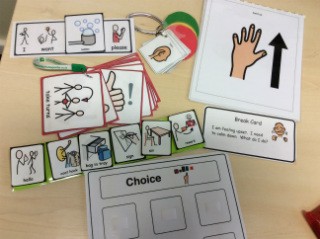Preparing an autism friendly primary classroom.
“The classroom is each teacher’s mini-kingdom and the ‘home’ of your pupils for most of the school day. Teachers lavish care and attention on how it is set out and how they decorate it, and spend time organising furniture and equipment that they and their pupils will need to access throughout the year. In primary classrooms, hours are spent printing and laminating and setting out displays, and carefully choosing words, pictures and prompts for pupils’ writing, maths and topic work. Coat pegs and drawers are labelled, boxes and books are given out and groups of tables are given a name. In the Early Years, parts of the room are often sectioned off into creative, ‘small world’ or sensory play areas and most classrooms have a common focus area, usually in front of the whiteboard, where pupils will gather to listen to the teacher presenting a lesson. At the beginning of the school year, the classroom is bright, stimulating, labelled, and ready for a new intake of pupils.”
Lynn McCann (2017) page 21
School can feel like this for pupils with Autism Spectrum Condition (ASC).”
Lynn McCann (2017) page 21
This is an excerpt from my book “How to support Children with ASC in Primary School” and there’s lots of advice and information about how to do just that in there.You can find it on LDA Learning Publishers website if you’re interested.
But in this blog I’m going to share some advice about how to get ready for an autistic child who might be coming into your class this September, starting with some key tips that can make a classroom autism friendly and yet suitable for all children. Then I will give you some tips on how to make yourself ready.
Environment
- Have a visual timetable and use it. Here you can read about why this can help children learn independence.
- Have clear spaces between display boards and keep displays simple.
- Leave clear space around whiteboards. Less chance of being distracted.
- Make sure where child is to sit is accessible for them, without having to navigate obstacles or pass lots of other children closely.
- Check light levels, noise from other rooms, smells and cut down on things hanging from the ceiling.
- It’s always best to start minimalist and let the child tell you what they can cope with on top of that. As they settle in you can involve the autistic child in what could go on the walls.
- Use table top vocabulary/maths reminders rather than word or number walls. Then you just get them out as needed and they are not there all the time.
- Keep clutter on top of cupboards and tables to the minimum.
Welcome
- Make a booklet reminding the pupil about their new classroom, with a picture of the class staff and an outline of what will happen on the first day back. Send it to the child’s home with a welcome note.
- Read the notes from the last teacher and highlight all the positive things about the child. Have a box of toys, magazines etc of their favourite things ready for them on the first day.
- Know their sensory profile. If they use headphones, have a storage place for them near their seat. If they have a wobble cushion, make sure it is ready for them on the first day back.
- Have whatever visuals they used in the last class, ready for them to use again (or a similar set if they need renewing). This is not the time to say they don’t need them anymore.
Inclusion
- Make plans to support the child and their peers to be able to interact well with them. This could be by setting up a games group, buddy system for playtimes or supporting partner work in class.
- Support the children to access classroom routines by having visual supports such as a schedule, or writing a ‘story’ for them about how things work in your classroom. Pictures and written instructions are easier to refer to and remember than verbal instructions. Make them positive and encouraging.
- Plan how the autistic child might access class lessons. They may need a whiteboard, visuals, a copy of the story book for themselves, a fiddle toy or a TA supporting them. Spend time with the TA beforehand to plan how this might work.
- Plan to teach the child yourself. Timetable this in, so that you are their teacher, not the TA. Be a team where you both know the child well.
Parents
- Find out the first names of the parents.
- Arrange a date to meet and listen to their story as soon as you are able to in the first couple of weeks. Just listen and get to know what their hopes for their child are. They will have some really helpful tips and information for you to support their child.
- Suggest a way to keep in touch regularly with them. A home-school diary works well.
Yourself
- Don’t feel overwhelmed by what you might not know. Ask for advice/help earlier rather than later.
- Plan time to plan regularly with your TA.
- Get to know the professional working with the child and make friends with them. They might do a lot extra for you (we do!)
- Read about autism by all means but don’t assume the child in your class will be just like the children you read about. Get to know them and their strengths as well as understand their frustrations.
- Be positive and calm in all circumstances. It is a child and behaviour is communication. That can help you ‘read’ what they are trying to tell you.
There is so much more I could tell you but then this blog would be too long. Please do look at my other blogs if you want to know more, and of course, as I’ve written the thing, I’d love you to buy my book as there’s loads of helpful stuff in there.
Enjoy your class this year.
Next time getting ready to teach children with autism for a secondary teacher.
​This work is licensed under a Creative Commons Attribution-NoDerivatives 4.0 International License.






Hello Jo,
I obviously don’t know your full story but there are requirements by schools to investigate and support special educational needs, the child doesn’t need to have a diagnosis. The best thing to start with is reading up on advice for you as a parent about what the law (and the SEND Code of Practice) says. For that I would recommend you visit http://www.ipsa.org.uk and http://www.specialneedsjungle.com and I know the National Autistic Society has some good advice on recognising and supporting autism in girls which can be quite different from the male profile that most people expect to see. I hope you manage to find the help your daughter needs.
Struggling parent 5 yr old in reception dsm5 autism spectrum,works mentally at age 3yr.has no understanding of everyday life danger safety etc,barely eats only (party food) beige colours only.
We are now on are 2nd school,1st .didnt work out on both sides.so we left on friendly note so I thought,
Meanwhile on the pathway already with speech lanuage therpist so new school signed up.
14th feb the old school reported me for isolating my child of a education an social services have been the nightmare to my child’s life since.
Should of had everything in place for September all ref by speech therpist senco teachers new school asd team.
Still nothing is done it’s all been either put on hold out told not needed
By ss all because it was proven to be fabricated by the old school
So as u can imagine my trust in professionals is very limited an since diagnoises my child hasn’t recieved any help what’s so ever in school our out
It’s like talking to brick wall,cause nothing has gone threw to them no asd is there no support needed.
What can I do to actually get my child the support an aids needed to help her